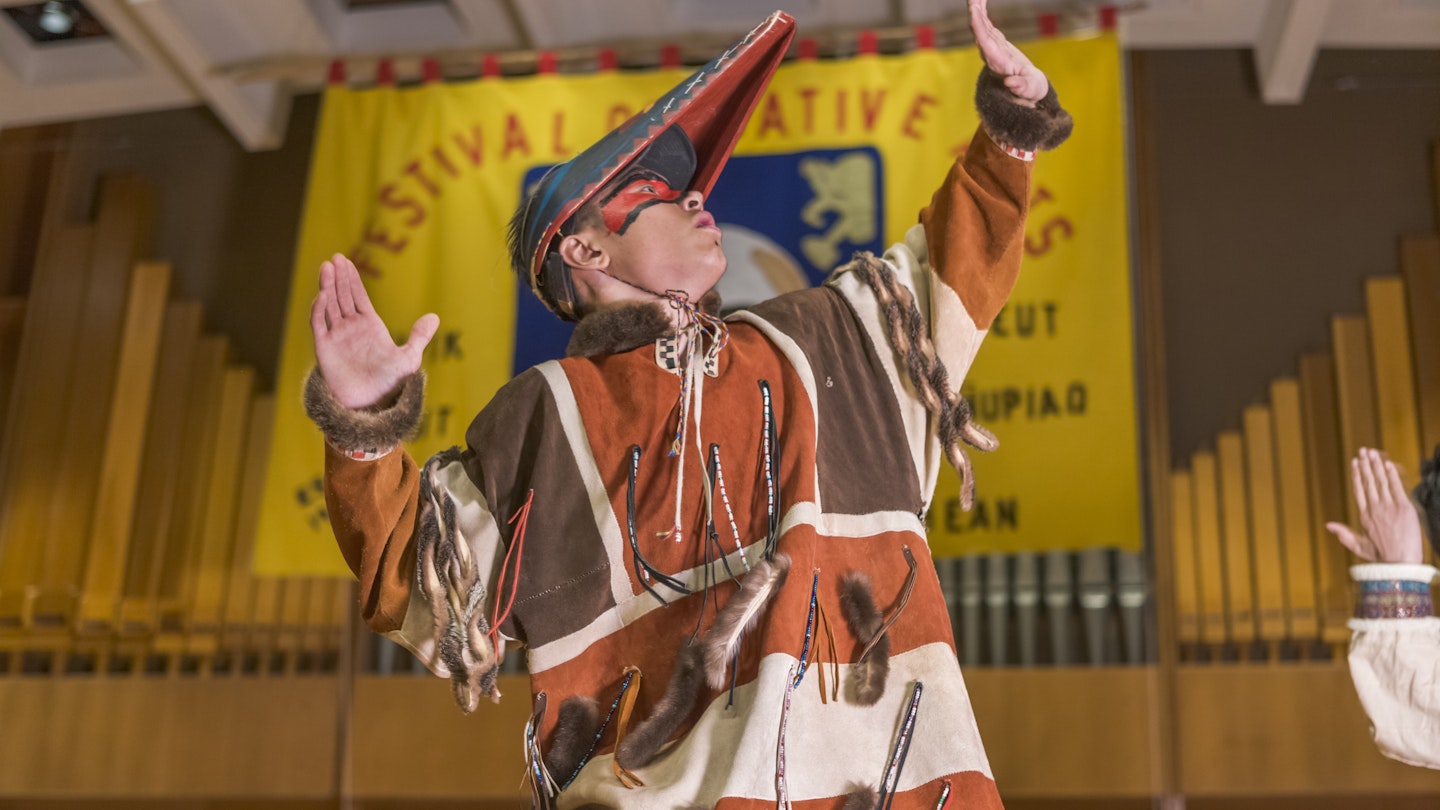Although well-known for its snowy mountains, lush rain forests, and incredible wildlife like bears, moose, and humpback whales, Alaska is also rich in the cultures of Alaska Native peoples. Their worldviews, language, singing, dancing traditions, and ways of life have been shaped by these lands – and indeed shape how visitors experience them.
Travelers to Alaska will learn about the traditions that have sustained Alaska Natives for thousands of years. It’s essential to ground oneself in the modern ways Alaska Native peoples celebrate and practice their culture around the state.

Explore Dog Mushing Traditions
Fairbanks is the ancestral and unceded traditional territory of the lower Tanana Dene peoples. While many Alaska Natives reside in the Fairbanks area, the largest representation includes Athabascan (Gwich’in, Koyukon, Lower Tanana, and others) and Iñupiaq people. Dog mushing is a tradition introduced to this region by Alaska Natives.
During late winter and early spring, communities cheer for their favorites in sprint dog races, such as the three-day Open North American Championships in mid-March. Mushers and spectators eagerly watch sprint times, picking out their favorite teams, and enjoy some much-needed daylight.
Attend the Festival of Native Arts in Fairbanks
A little later in March, the Festival of Native Arts at the University of Alaska Fairbanks allows visitors to experience Alaska Native singing and dancing while learning about rich cultures and storytelling. Performances from the Dena’ Intertribal Dancers showcase Athabascan songs and dances, where individuals can also practice the dances and feel the power of the drum.
Cheer on Incredible Survival Skills at the World Eskimo-Indian Olympics
Dog mushing isn’t the only sport popular among Alaska Native people. In July, traditional Alaska Native sports are on display at the World Eskimo-Indian Olympics (WEIO). Games showcase the skill and preparedness essential for survival across the region, including fish-cutting contests and the two-foot high kick, where athletes kick a seal skin ball hanging from a rope. Camaraderie is integral to the event, as athletes cheer each other on. Watch dance group performances, the Miss WEIO pageant, and regalia contests as well.
Listen to Athabascan Fiddling
Look forward to more foot-stomping dancing and fiddle music later in the year with events like the Athabascan Fiddlers Festival, featuring over 80 performers ranging from elders to youth musicians celebrating Athabascan culture and traditions. The Gwich’in Athabascan Fiddle Dance often takes place in November, where participants enjoy traditional dances wearing beautiful beaded moosehide mukluks and other attire.
Admire Interior Alaska Native Cultural Exhibits
A visit to the interior wouldn’t be complete without stopping by the Morris Thompson Cultural & Visitors Center, showcasing Alaska Native lifestyle exhibits, artwork, and history. Visitors can admire the innovative beaded designs of Alaska Native artists, observe the resurgence of fish skin processing, and discover unique creations like salmon leather jewelry, bags, and baskets.

Celebrate with a Blanket Toss at Nalukataq
Travel to Utqiaġvik (formerly Barrow) in late June to experience Nalukataq, celebrating the gift and spirit of the bowhead whale and the successful whaling crews that provide for their community. Local Iñupiat whaling crews serve the community with various whale cuts, locally prepared bread, caribou, goose soup, and other delicacies to sustain them through winter.
Nalukataq culminates in a blanket-toss celebration and traditional dancing. The event, meaning “to be tossed up and down on a bearded sealskin blanket,” highlights people being tossed high into the air, often displaying flips and tricks in traditional parkas. Another exciting part is tossing candy, delighting children.
Learn Native Dance at the Yup’ik Celebration in Western Alaska
Dance plays a vital role in many Alaska Native communities. It preserves oral traditions, culture, language, and survival lessons, while also being a time to celebrate. In Mamterilleq (Bethel), the Cama-i Dance Festival takes place in March, continually celebrating Yup’ik culture and traditions. Dancers often wear vibrant floral qaspeqs (summer parkas), mukluks, and beaded fur headdresses, sharing songs about seal hunting or historical events. Visitors can also explore vendor booths showcasing carved masks, jewelry, and crafts.
Join the Festivities at Southeast Alaska’s Celebration
Every other year in early June, one of the largest gatherings of Southeast Alaska Native peoples is held to celebrate Tlingit, Haida, and Tsimshian cultures. The four-day Celebration festival fills the streets of Juneau with Native people embracing their heritage while dressed in traditional regalia. This event features traditional food, arts, and cultural artistry, highlighting the rich cultural offerings of the A’akw Kwáan and T’aaḵu Kwáan homelands.

Discover Native History and Traditions at the Alaska Native Heritage Center
Many visitors to Alaska find themselves in Anchorage, known as Dena’ina ełnena, the traditional homeland of the Dena’ina people. The Alaska Native Heritage Center is a must-visit cultural institution, featuring traditional Alaska Native homes, community gathering spaces, and educational programs. Museum docents share stories and artifacts explaining living practices, while special events highlight Alaska Native dance and storytelling.





